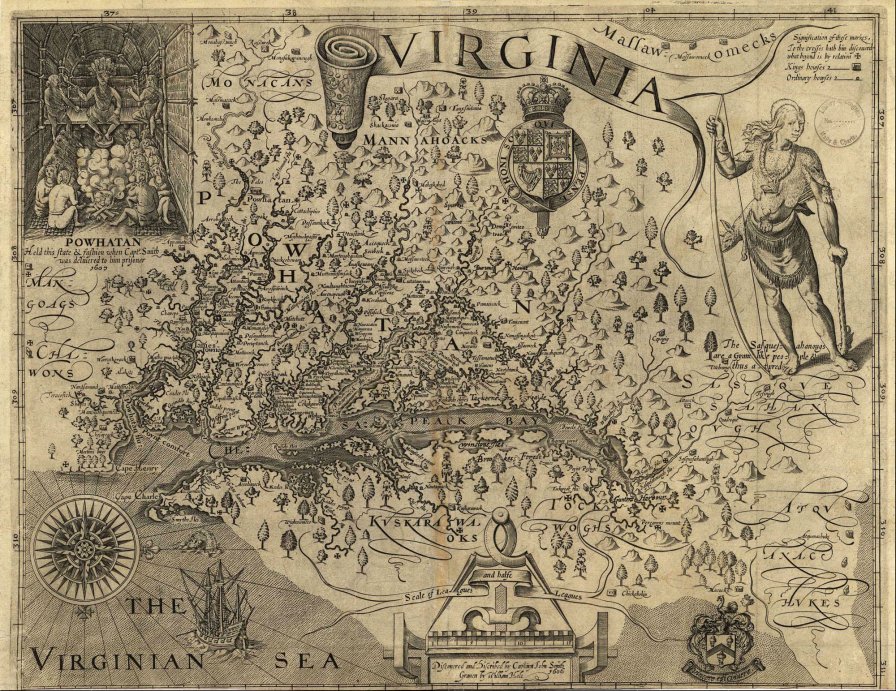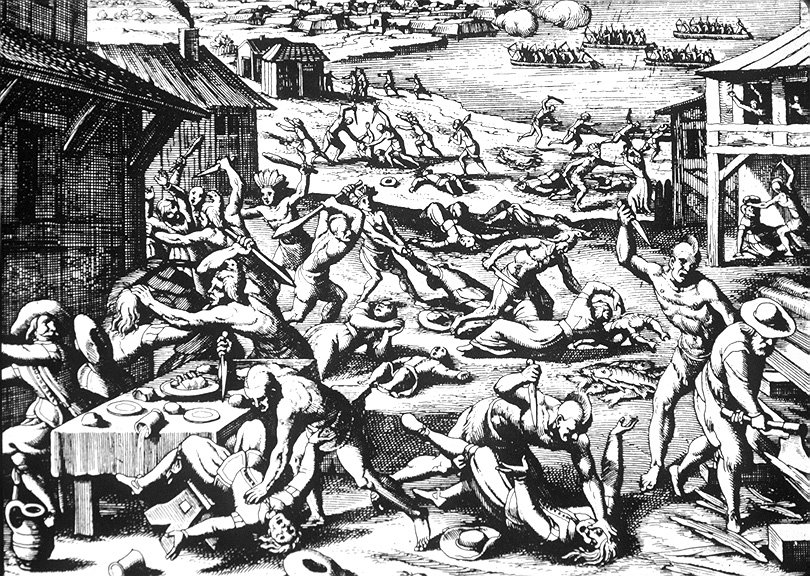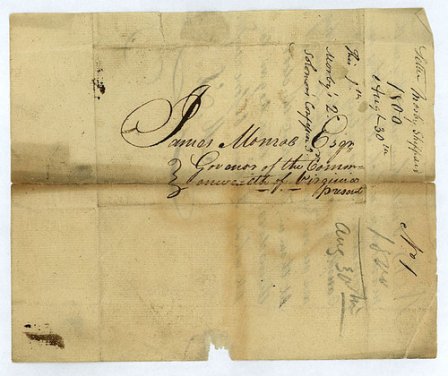Part I, The Virginia Monologue
The frontier limit had always defined the shape and pace of empire, and Richmond, VA belonged to the frontier. “As early as 1608,” writes Matthew S. Gotlieb, “the English settlers eyed a community near the [James River’s] seven-mile-long series of rapids that […] provided a series of strategic advantages: as a port, as a location for mills, and as a transitional territory between the Tidewater-based Powhatan Indians and the Monacan Indians of the Piedmont.”1 Among its other qualities, it was this transnational nature, the geopolitical fall-line personified by the river falls, that bestowed the village territory — till then known to the native Powhatan people as Shocquohocan, or simply Powhatan — with a preternatural aura of liminality and uninheritability.
Vice Admiral Christopher Newport, delegated leader of the Virginia Company of London’s Jamestown project, immediately noted the high, southerly hill just beyond the falls — the seat of one of mamanatowick Powhatan’s weroances, Parahunt — and, because Paradise would always belong to the fair, he soon became obsessed with the location and the notion of strategic military intervention there, that on behalf of the Powhatan against their rivals the Monocan. After meeting Parahunt at the falls, Newport returned downriver where he erected, on one of the islands, a cross, reading Jacobus Rex, 1607. George Percy wrote, “The foure and twentieth day [of May] wee set up a Crosse at the head of this River, naming it Kings River, where we proclaimed James King of England to have the most right unto it.”2 This seemingly inconsequential locus of exchange and transition, between the river rapids, the high hill, and the “Crosse,” was to become the area to which Richmond upon Thames would (possibly) lend its name.3

The land the English christened Virginia had, for thousands of years, been party to various indigenous communities. Yet between 1607 and 1645, the region that the people of the Powhatan Confederacy called Tsenacommacah — literally, “densely-populated land”4, an area encompassing what is now Tidewater Virginia and parts of the Eastern Shore — swiftly became red: with blood and by ensign. Despite several serious setbacks for the colonists (primarily disease), two of the most consequential events of Anglophone North America’s first half-century, the Indian massacres of 1622 and 1644, delineate, rather, the paradoxical beginning of the end for Powhatan hegemony in Tsenacommacah, book-ending a series of asymmetric, low-intensity armed conflicts that, by the mid-1640s, left the Powhatan people devastated and without recourse. As the popular historian Camilla Townsend narrates, “the cultural heirs of people who had been full-time agriculturalists for eleven thousand years rather than a few hundred had already won the [agro-technological arms race].”5 Thus, the English colonists, over just a few decades, were effectively able to suppress and practically eliminate indigenous resistance.
Although sometimes called the Jamestown massacre, the event of 1622 largely spared the residents of that settlement, due to a timely last-minute warning detailed in a correspondence to the Virginia Company, dated a year later, from April 4, 1623. Residents of Henricus, located near the site of Powhatan, were not so lucky. From the “Voyage of Anthony Chester” (1707):
When the day appointed for the massacre had arrived, a number of the savages visited many of our people in their dwellings, and while partaking with them of their meal the savages, at a given signal, drew their weapons and fell upon us murdering and killing everybody they could reach sparing neither women nor children, as well inside as outside the dwellings. In this attack 347 of the English of both sexes and all ages were killed. Simply killing our people did not satisfy their inhuman nature, they dragged the dead bodies all over the country, tearing them limb from limb, and carrying the pieces in triumph around. 6

Part II, Conspiracy
From the Testimony in the Trial of Gabriel, October 6, 1800:
Gabriel was appointed Captain at first consultation respecting the Insurrection and afterwards when he had enlisted a number of men was appointed General[.] That they were to kill Mr[.] Prosser[,] Mr. Mosby[,] and all the neighbours, and then proceed to Richmond, where they would kill [everybody], take the treasury, and divide the money amongst his Soldiers after which he would fortify Richmond, and proceed to discipline his men, as he apprehended force would be raised elsewhere to repel him[.] That if the White people agreed to their freedom they would then hoist a White flag, and He [Gabriel] would dine and drink with the merchants of the City, on the day when it should be so agreed to[.] 7
In 2007, then-Virginia Governor and later Vice Presidential candidate Tim Kaine issued an informal “pardon” of the slave Prosser’s Gabriel, hanged in Richmond in the year 1800, with at least 25 other Afro-Virginians, for leading a failed slave revolt. In restoring the slave Gabriel’s “good name” over two centuries too late, Kaine said that Gabriel was motivated in part by his “devotion to the ideals of the American [R]evolution.” “It was worth risking death to secure liberty,” Kaine remarked solemnly.8
Although no doubt with admirable intention, Governor Kaine was mistaken with regard to some facts about Gabriel. Exceptionalist rhetoric aside, Gabriel, if anything, was motivated not by the Enlightenment, small-R republican ideals contained by the American Revolution — those that ultimately excused and made room for the newborn States’s “peculiar institution” — but rather by those embodied and enacted roughly a thousand miles south, as part and product of the contemporary slave rebellion on the French Caribbean colony of Saint-Domingue. The révolution haïtienne — the most successful slave uprising since Spartacus’s 1,900 years earlier, the only one that led to the founding of a state free from slavery, one ruled by non-whites and former captives — led many enslaved blacks, especially those literate ones like Gabriel, to believe that the opportunity for freedom was finally at hand.9

Gabriel himself, a blacksmith who, due to the unique terms and conditions of his enslavement, enjoyed a fluid form of quasi-freedom10, wore a distinctly and romantically black politics, at a time when black consciousness in the Americas could only be said to be nascent. More than a half-century ante-Marx, Gabriel believed his planned rebellion would “spark a class struggle” that had a recognized purpose and might “force specific concessions from the state authorities.”11 In spite of his literacy and social awareness, the circumstances of Gabriel’s condition comprised no accident. In his landmark text “Gabriel’s Conspiracy and the Election of 1800,” the historian Douglas R. Egerton notes that the conspiracy itself — though failed, it remains one of the most consequential slave rebellion plots in American history — cannot be “divorced from the world of Richmond in the years following the American Revolution.”12
Part III, PARADISO
Lo! Death hath rear’d himself a throne
In a strange city, all alone, […]
Where the good, and the bad, and the worst, and the best,
Have gone to their eternal rest.
– Edgar Allan Poe, “City of Sin”
And in the same way, He took the cup after they had eaten, saying, “This cup which is poured out for you is the new covenant in My blood…”
– Luke 22:20
And the beast was taken, and with him the false prophet that wrought miracles before him, with which he deceived them that had received the mark of the beast, and them that worshipped his image. These both were cast alive into a lake of fire burning with brimstone.
– Revelation 19:20
When castings are required, the metal is employed, as in the case of other metal, in a molten state, and is poured into moulds previously prepared for it; in large … complicated objects they are cast in separate parts which were afterwards joined by solder. The great improvements of which have recently been made in the mode of casting metal enabl the manufacturer to produce articles of the most elaborate and ornamental character, as was shown in many of the castings of iron, zinc, &c., in the Great Exhibition.
And he took the gold from them and, hammering it with an instrument, he made it into the metal image of a young ox: and they said, This is your god, O Israel, who took you out of the land of Egypt.
– Exodus 32:4
1. Gottlieb, Matthew S. “Richmond during the Colonial Period.” Encyclopedia Virginia. Virginia Foundation for the Humanities, 8 Jan. 2016. Web. 8 May. 2017.
2. Percy, George. “Observations by Master George Percy, 1607.” In Narratives of Early Virginia, 1606 - 1625., edited by Lyon Gardiner Tyler. 1st ed. New York, NY: Charles Scribner’s Sons, 1907. 1998. Accessed May 9, 2017. http://www.virtualjamestown.org/VVD4SJBL.html.
3. Gottlieb.
4. Sweet, David G., and Gary B. Nash. Struggle and Survival in Colonial America. 1st ed. Berkeley (Calif.): University of California Press, 1981.
5. Camilla Townsend, Pocahontas and the Powhatan Dilemma, 1st ed., paperback. (New York: Hill and Wang, 2005). p. 224
6. “Two Tragical Events.” William and Mary Quarterly 9, no. 4 (April 1901): 204–214.
7. Trial of Gabriel. Testimony in the Trial of Gabriel, October 6, 1800, Governor’s Office, Letters Received, James Monroe, Record Group 3, Library of Virginia. 1-4. General Court. 6 Oct. 1800. Encyclopedia of Virginia. Virginia Foundation for the Humanities, 12 July 2012. Web. 9 May 2017.
8. Schapiro, Jeff. “Kaine issues pardon in slave revolt.” Richmond Times-Dispatch, August 31, 2007. Accessed May 9, 2017. http://www.richmond.com/news/article_5b76c106-ea47-5727-ab57-18cc7ce7ac2….
9. Knight, Franklin W. “The Haitian Revolution.” The American Historical Review 105, no. 1 (February 2000): 103. doi:10.2307/2652438; Egerton, Douglas R. Gabriel’s Rebellion: the Virginia Slave Conspiracies of 1800 and 1802. 1st ed. London: The University of North Carolina Press, 1993.
10. Egerton, Douglas R. “Gabriel’s Conspiracy and the Election of 1800.” The Journal of Southern History 56, no. 2 (1990): 191-214. doi:10.2307/2210231.
11. Egerton, Douglas R. Gabriel’s Rebellion: the Virginia Slave Conspiracies of 1800 and 1802.
12. Egerton, Douglas R. “Gabriel’s Conspiracy and the Election of 1800.”; Genovese, Eugene D. From Rebellion to Revolution: Afro-American Slave Revolts in the Making of the Modern World. 3rd ed. Baton Rouge, LA: Louisiana State University Press, 2006.
More about: Chino Amobi, Diamond Black Hearted Boy




